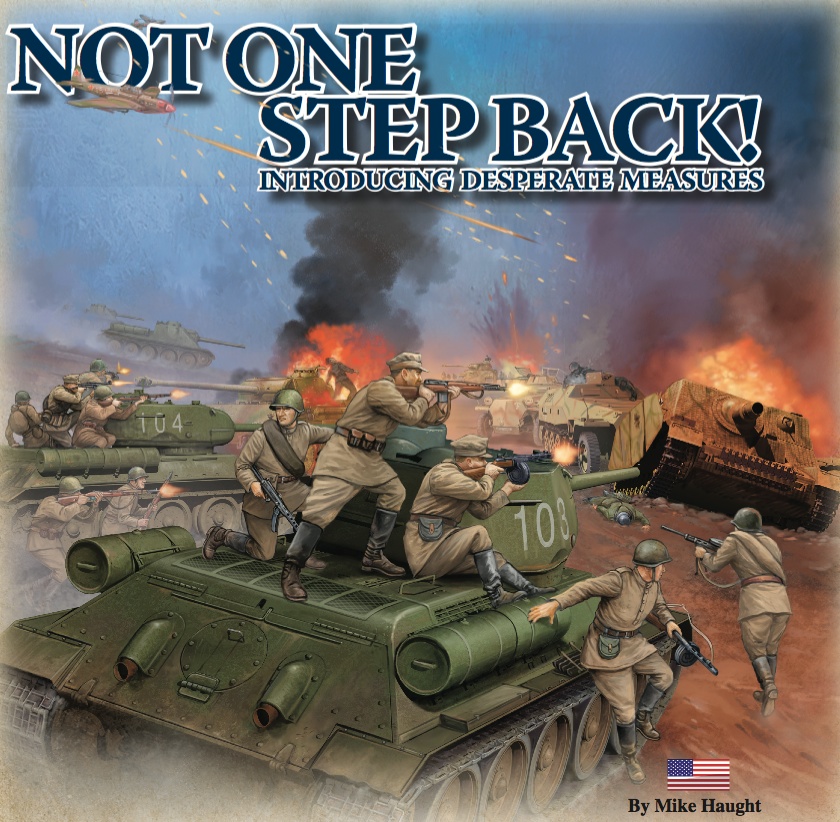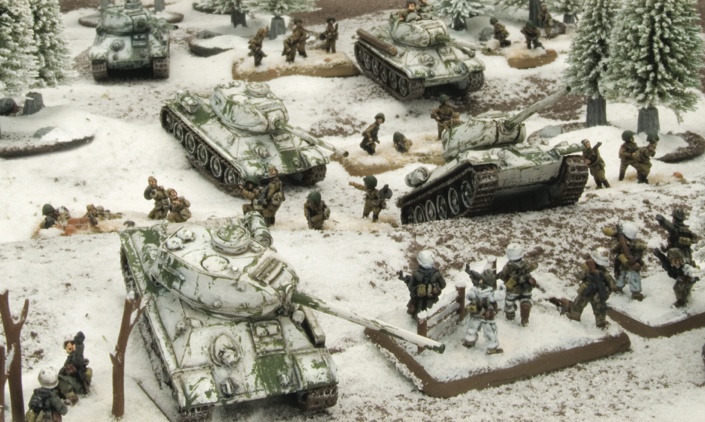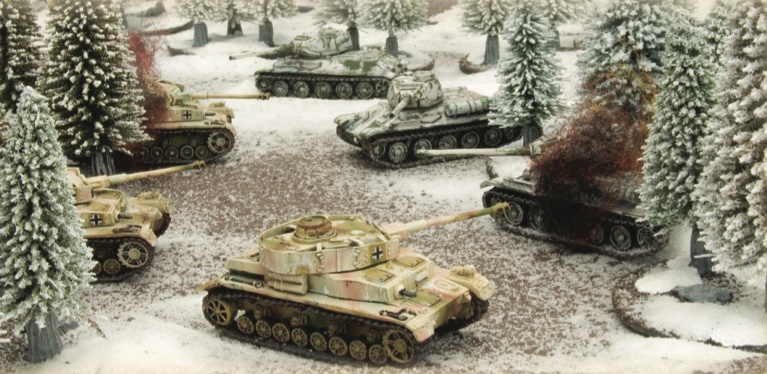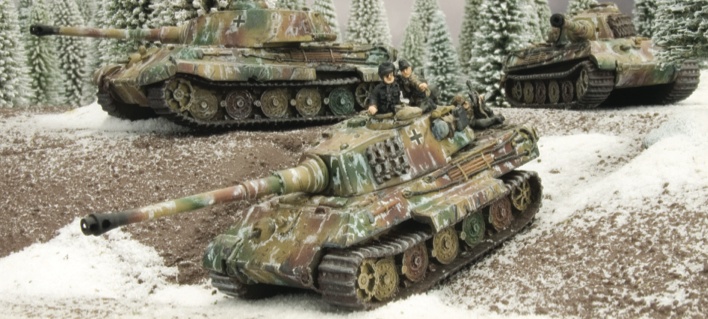Desperate Measures Design Notes
 |
| It’s 1945 on the Eastern Front. Its a brutal, fierce, and desperate fight. The Germans are fighting at the borders of the Reich. Many of the soldiers can see their homes and will stop at nothing to prevent the Red Army from reaching them. For the Soviet soldier it is a time for revenge. Years of fighting and liberation have finally delivered the moment of crushing their fascist enemies completely. They too, will stop at nothing to make that happens. Enter into the final battles of World War II, starting with Desperate Measures. The history of World War II during December 1944 and January 1945 often focuses on Hitler’s grand Ardennes Offensive, known popularly as the Battle of the Bulge. However, while Germany’s finest troops were fighting to reach Antwerp in Belgium, long and bloody winter battles raged unabated across Eastern Europe. Stalin’s forces, positioned in Poland on the Vistula River, launched a general Winter Offensive aimed at reaching the Oder River, the eastern border of the Reich itself. Meanwhile, Hitler and his staff sent armies and divisions, many formed overnight, to meet the Red Army in Poland, Prussia, and Hungary. The battles on the Eastern Front, already desperate and merciless, are about to get even more so as the war closed in on the Third Reich’s heartland. What is Desperate Measures? Desperate Measures is the latest Flames Of War supplement book. It takes players into the tough tank battles of early 1945 on the Eastern Front. The book offers tank and mechanised companies and battalions for German and Soviet armies. It also includes a general history of armoured operations in the East from January to March 1945. The book incorporates all of the Soviet changes rolled into Red Bear (for more information on these changes, see the previous article: Back to the USSR). So it includes the updated Hen and Chicks points for T-34 tanks, new and improved Katyusha rocket launchers, and expanded medium assault guns. However, there is a lot more to explore and try out within the pages of Desperate Measures as we push the Flames Of War timeline right up to the gates of Berlin! 1945: The Beginning of the End? Desperate Measures marks the beginning of a very dynamic and exciting part of the Second World War. The moment of truth is upon your armies. If you are an Allied player, this is the moment your troops have been fighting for all these years. The gates to Germany are in front of you, however they are well-guarded. If you are a German player, the enemy is at the doorstep of your homeland, but your men have known victory and they will fight hard to make sure that the sacrifices of their countrymen are not in vain. The war will rage on... As wargamers we know that the end of the war is coming, but as field commanders of miniature men, we want to do everything in our power to write the end of our own stories. 1945 is upon us—how will it end on your tabletop?  Soviet Forces in Desperate Measures Soviet Forces in Desperate MeasuresThe Red Army: 1945 Stalin’s Red Army underwent some changes in 1945. It had evolved to meet the demands of modern warfare. As a result the Soviets in this book are represented in two ways. The first is the relatively fresh forces that are a bit more familiar to the veteran player. It includes the full-strength variants of forces as they reach the front line and prepare for their first offensives. These are the troops that may have experienced some combat, but their biggest fight is still ahead of them. Opposite the fresh troops are the experienced troops of the Red Army’s long-serving units. We have called these Hero units to represent their status and accomplishments. Their hardest challenges have been overcome and for them it’s all about finishing the job and avenging their fallen comrades. Their companies are much smaller than the fresh units, but they are more experienced know how to get the most out of their equipment. Desperate Measures includes two types of forces: fresh and Hero. Both the standard Red Army and fearless Guards divisions are represented in the two types so that you can field your favourite unit as Heroes. The forces in the book include a normal and Hero version of a Tankovy (tank) and Motostrelkovy (mechanised infantry) battalion, and a Sredniy Samokhodno-artillyeriyskiy (medium assault gun) regiment, as well as all of the usual Soviet support companies, ranging from the ubiquitous Katyusha rocket launchers to the hard-hitting heavy assault guns. Fresh Soviet Forces The fresh divisions represented in Desperate Measures are at full strength and are organised nearly identically to those forces found in Red Bear. If you enjoy commanding large tank and mechanised forces, then the fresh division options are your first option. They do, however, have some slight changes to the 1944 Soviet forces in Red Bear, like motorised artillery for tank battalions and captured Panzerfausts for the infantry. Such features will set these later troops aside from their earlier comrades.  Heroes of the Soviet Union The Hero of the Soviet Union was the highest award given by the Red Army for extreme bravery and accomplishment in battle. Our Hero units in Desperate Measures draw on this rhetoric. Even though not all of the soldiers of these units have received the award, their accomplishments are legendary nonetheless. They are survivors and they are tireless. The enemy must be defeated and they certainly know how to do it. The Hero platoons themselves are small, reflecting the nature of a spent Soviet force at the conclusion of a campaign. As a quick example, the 23rd Tank Corps joined the Third Ukranian Front on 25 January 1945. It was nearly at full strength with 174 of its T-34 tanks in operation, a full complement being 189. After just three months of combat, it had 34 tanks remaining in March! With the end of the war in sight, units such as these were not reinforced but rather kept in the front line, relentlessly pushing toward the final victory. It is at this point that we join the Hero formations in Desperate Measures. These survivors have learned vital lessons and they are ready and able to see this thing through. Vasili Pavolovich Bryukhov, a Red Army tankman, once commented on surviving the Eastern Front saying, ‘Only the luckier, smarter, and sharper crews made it out alive.’ We have used his quote to give the Hero units three special rules reflecting their ability to survive and fight. Luckier The commanders of Hero units survive battle after battle and come through the otherside with more than a little luck. This rule makes it harder to kill company and 2iC command teams, ensuring they will remain on the battlefield to motivate your men onto final victory. Smarter Hero units are still rated Trained, to reflect the political and tactical command and control problems that plagued the Soviet army throughout the war. However, once committed to a specific task, the individual soldier’s experience overcomes these disadvantages. Where normal Trained troops successfully pass Skill Tests on die result of 4+, Hero units accomplish Skill Tests on a 3+. This will benefit them in hand-to-hand combat, clearing buildings and obstacles, and firing artillery bombardments. Sharper Hero tank units also benefit from combat experience and lose the Hen and Chicks special rule, giving them greater freedom in battlefield manoeuvring. This will open up new tactics for seasoned Soviet players and offer a whole new way to play Comrade Stalin’s tank armies.  German Forces in Desperate Measures The Germany Army: 1945 The German army fought hard against the Red Army. Unable to hold a constant frontline, Hitler ordered his men to hold fortress cities and vital river crossings. With the bulk of the panzer troops deployed in the West, the eastern panzer divisions were held in reserve to launch counterattacks to secure strategic objectives, like oilfields and refineries. The German situation was tough, but not impossible. The troops’ morale remained high. Some took faith in the Wunderwaffen, or wonder weapons, like the V1 flying bombs and V2 rockets, while others believed that if they could hold the Soviets off long enough for the Western Allies to advance, they could spare Germany from Stalin’s revenge, and perhaps even join forces against the scourge of communism. No matter what they believed, victory was still achievable. After the winter offensives of late 1944 and early 1945, the German Panzertruppen (armoured troops) were faced with a shortage of experienced personnel to command their units. The solution was to simplify the panzer division’s organisation into a lean, mean fighting machine to make it easier for the new officers to command. Furthermore, it infused an incredible amount of versatile firepower directly into the units. Enjoy the War… The main special rule that the Germans benefit from in Desperate Measures is the Enjoy the War rule. This rule reflects the situation each German soldier found themselves in during 1945 as the Allies (in particular the vengeful Soviets) closed in on Germany. The way Enjoy the War works is that when a platoon has to take a platoon morale check, instead of rolling one die for the whole platoon, you will roll a dice for each team in the platoon. On a result of 3+, the team stays and fights on. On a 1 or 2, the team decides it has had enough and is destroyed. Essentially when the situation gets tough, the decision to stick it out is up to each individual team, rather than the whole platoon. Panzer Kampfgruppe For the tank crews, the 1945 panzer army reorganisation meant added self-propelled anti-aircraft support and Begleit (escort) infantry. The divisions were also equipped with some of the best tanks, assault guns, and tank-hunters. The Panzerkompanie from Desperate Measures will have access to all of Germany’s finest tanks and tank-hunters. You, as the commander, will be able to construct some excellent battlegroups with a different tanks to deal with each problem you will face on the battlefield.  Panzergrenadier Kampfgruppe For the armoured panzergrenadiers, the changes in the panzer division structure in 1945 removed the company’s heavy weapons and replaced them with more useful integrated flak half-tracks, which could put out the same amount of firepower as the old equipment in addition to covering the grenadiers from enemy aircraft. Furthermore, new battalions received StG44 assault rifles to fit out a platoon in addition to the traditional platoons armed with reliable MG42 machine-guns. Finally, every platoon had plenty of the fearsome Panzerfaust anti-tank launchers to guard against enemy tanks. They also had access to the new powerful vehicle, the Sd Kfz 251/22, a half-track armed with a 7.5cm PaK40 anti-tank gun. This was available in large numbers both as a weapons platoon as well as in the attached Panzerjäger Abteilung (tank-hunter battalion). These changes give the panzergrenadiers an astonishing amount of firepower! Panzer Ausbildungs Verband In March 1945, an emergency plan went into effect to mobilise every last panzer, self-propelled gun, and vehicle in Germany’s tank training schools (such as Paderborn and Bergen) into combat units to oppose the Red Army and the Western Allies. With the threat to Germany increasing each day, these schools organised their assets into Panzer Ausbildungs Verbände (Replacement Tank Forces). These had a very interesting variety of tanks and equipment, ranging from old Panzer II F light tanks to refurbished Porsche-model Königstiger tanks. With this force, you take on the role of a panzer instructor and lead your students into battle. You will have a wide selection of training tanks. Though old, these are still lethal fighting machines. |

Ingen kommentarer:
Legg inn en kommentar